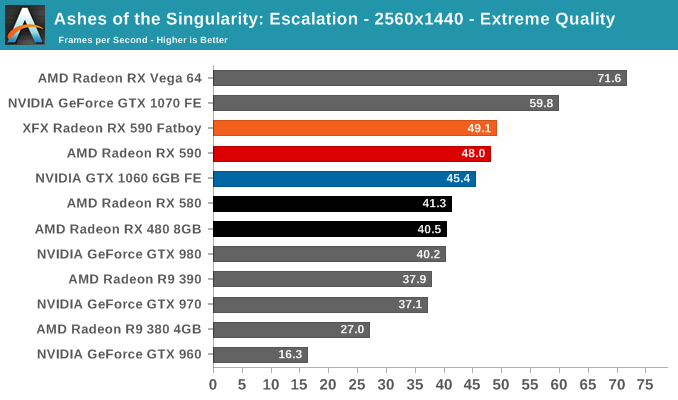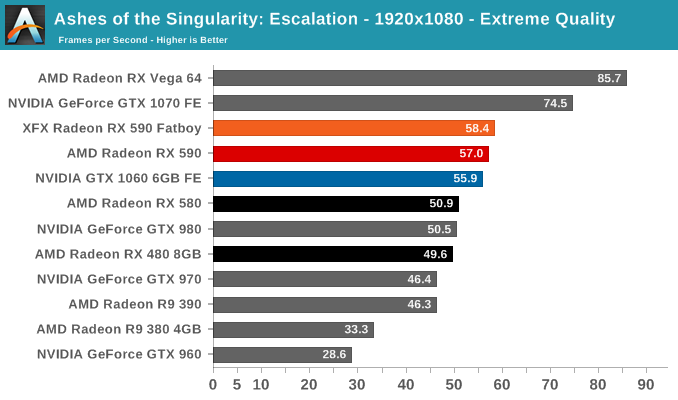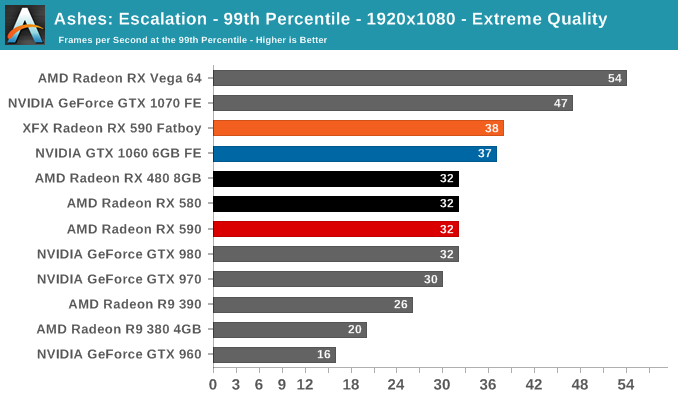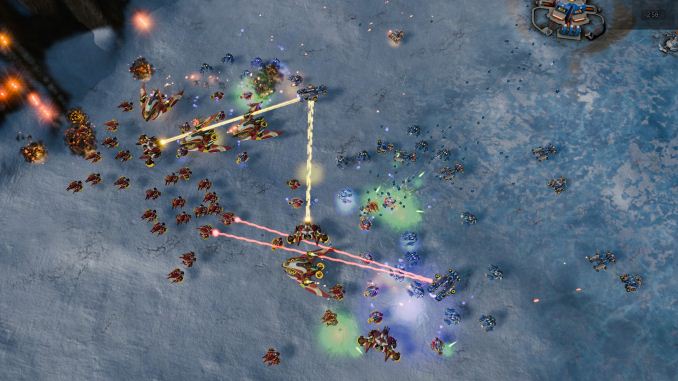The AMD Radeon RX 590 Review, feat. XFX & PowerColor: Polaris Returns (Again)
by Nate Oh on November 15, 2018 9:00 AM ESTAshes of the Singularity: Escalation (DX12)
A veteran from both our 2016 and 2017 game lists, Ashes of the Singularity: Escalation remains the DirectX 12 trailblazer, with developer Oxide Games tailoring and designing the Nitrous Engine around such low-level APIs. The game makes the most of DX12's key features, from asynchronous compute to multi-threaded work submission and high batch counts. And with full Vulkan support, Ashes provides a good common ground between the forward-looking APIs of today. Its built-in benchmark tool is still one of the most versatile ways of measuring in-game workloads in terms of output data, automation, and analysis; by offering such a tool publicly and as part-and-parcel of the game, it's an example that other developers should take note of.
Settings and methodology remain identical from its usage in the 2016 GPU suite. To note, we are utilizing the original Ashes Extreme graphical preset, which compares to the current one with MSAA dialed down from x4 to x2, as well as adjusting Texture Rank (MipsToRemove in settings.ini).


With Ashes, the RX 590 performance uplift over the RX 580 pays off in terms of beating its main competition, the GTX 1060 6GB. The lead is slim enough, however, that custom GTX 1060 6GB cards could easily make up the difference. With the price premium the RX 590 has over the GTX 1060 6GB, the reference GeForce is a little too close for comfort.


While not particularly known as a VRAM-eater, Ashes at 1440p brings down the GTX 960 and its anemic 2GB framebuffer, though it wouldn't be managing playable framerates anyhow.











136 Comments
View All Comments
Opencg - Thursday, November 15, 2018 - link
Its just a gap filler. It will help them make money from people wanting to get good performance at that price but... we're still waiting for the serious contenders. Vega refresh will be a little more toward the high end but... navi is where amd could potentially shift the market. RTX means you pay more for less performance outside rtx games. Navi is the opposite you pay less and get more. We need navi to function well and I believe amd can do it.neblogai - Thursday, November 15, 2018 - link
Is is not a gap filler. It is only there, because overproduction of P20 needs to be sold out first. Naturally- P30 should be a replacement of P20, at same price, with minimal investment by MAD or partners.eva02langley - Thursday, November 15, 2018 - link
Polaris is selling well, Vega, not so much beside mining. In Canada, the price are still having a huge price tag because the supply is just so low.Allan_Hundeboll - Thursday, November 15, 2018 - link
I am surprised a boost frequency increase of 15% nets 12% overall performance. Maybe Polaris isn't as starved for memory bandwidth, as people seem to think. Or AMD made other improvements besides the increased frequency...?mapesdhs - Thursday, November 15, 2018 - link
Frequency increases rarely produce linear performance gains, not when there are so many other aspects of a system that impact what's happening (main CPU, API, game engine, etc.)Allan_Hundeboll - Thursday, November 15, 2018 - link
Yes that is why I'm surprised 15% increase on the core frequency -without any increase of the Vram frequency, would result in 12% overall performance increase. Especially considering the "original Polaris" rx480 was configured with 1266Mhz core boost frequency and 2000Mhz Vram.If AMD figured 1266/2000MHz was near the sweet spot balance between core/mem speed then 1545/2000 would be severly starved for memory bandwidth.
So I'm wondering if 2000MHz memory speed was kind of wasted on the rx480? Or did AMD tighten the Vram timings on this new 590? Or maybe the near linear increase in performance is due to the higher tdp allowing the rx590 to sustain the boost clock while the 480 would throttle to base core frequency of 1120MHz?
SlowSpyder - Thursday, November 15, 2018 - link
Where is 7nm Vega??mapesdhs - Thursday, November 15, 2018 - link
Never going to happen, because gamers won't buy it.https://www.youtube.com/watch?v=guK2XoFbPFw
https://www.youtube.com/watch?v=USMlET3L7mA
Cyborg997 - Thursday, November 15, 2018 - link
Summer 2019 or late 2019. Definitely soon rtx fighter.schujj07 - Thursday, November 15, 2018 - link
The most surprising thing to me is just how good RX480 is when you look at the benchmarks. When it launched it was as fast as the GTX970, now it is faster than then GTX980 just due to drivers and newer games being able to use its resources better.